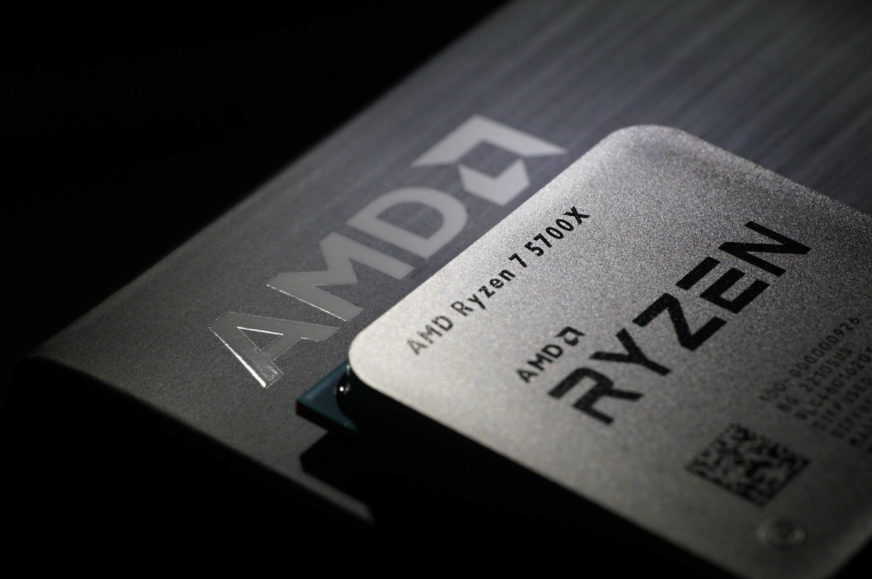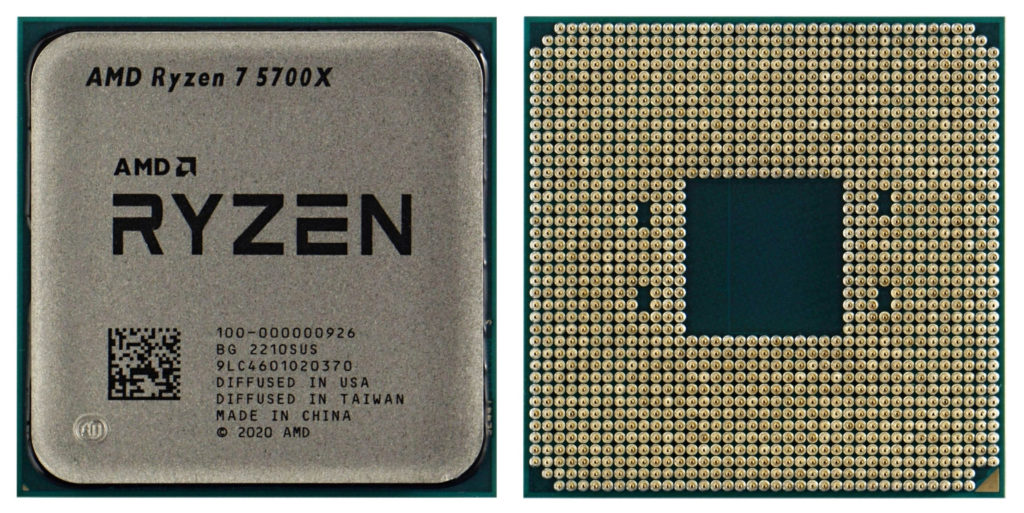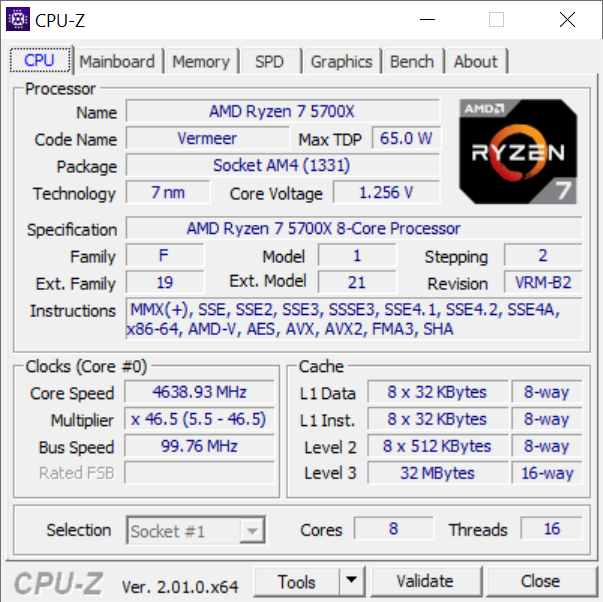AMD Ryzen 7 5700X in detail
At the eleventh hour, but still. The long-awaited Ryzen 7 5700X is here. However, we won’t be writing about the successor to the Ryzen 7 3700X as a significantly cheaper alternative to the Ryzen 7 5800X. The new octa-core Ryzen 7 5700X is primarily more economical compared to the higher-end model. Its power draw is just half in some tasks, which means that temperatures are also significantly lower.
AMD Ryzen 7 5700X in detail
Almost a year and a half after the release of the first Ryzen 5000 (Vermeer) processors. AMD has added the Ryzen 7 5700X to this generation, among other models that will be covered in following tests. And really at the last minute. Slowly, not only the Ryzen 5000’s lifecycle is coming to an end, but also the AMD AM4 platform as a whole. As early as this year (probably in September), Zen 4/Ryzen 7000 (Raphael) processors will be released for the new AMD AM5 socket. The models with accelerated clock speeds with the XT designation will most likely no longer be coming.
But in the case of the 8-core Vermeers, the Ryzen 7 5800X is already very aggressively clocked and Although the power draw of up to 147 W (and more realistically even a bit lower when we take into account the efficiency of the motherboard power delivery) is not terrible, the cooling requirements are still quite high. However, the Ryzen 7 5700X is supposed to reduce them significantly. It has a lower TDP (65 instead of 105 W) and PPT limit (76 instead of 142 W). While the computing part is still concentrated in a single chiplet, AMD hasn’t pushed the 5700X so hard and the clock speeds are significantly lower. In terms of base frequencies by 400 MHz.
While the Ryzen 7 5700X is supposed to run at 3.4 GHz at TDP (65 W), the Ryzen 7 5800X is at 3.8 GHz. But the difference in all-core boost frequencies is even more substantial – 500 MHz. That’s why you won’t push the R7 5800X with unlimited PPT limits below 80°C under load, even with the most powerful tower coolers. The Ryzen 7 5700X is slower, but it can be run at lower noise levels even with cheaper coolers. Looking back a generation, the Ryzen 7 3800X was also more power-hungry compared to the Ryzen 7 3700X (the predecessor of the R7 5700X). But the latter didn’t push it to the PPT limit.
The Ryzen 7 5700X has a slower single-core boost as well, but officially only by 100 MHz, unofficially by 200 MHz. There’s no point in bumping it down significantly, and AMD certainly didn’t want to bring it below the Ryzen 5 5600X. A single core load can be handled below 70°C by an average cooler (or better, but very quiet) even at higher frequencies. In the case of the R7 5700X (and R7 5600X), it’s 4.6–4.65 GHz. Additionally, single-threaded workloads don’t run on a single core, but over time (workload duration) the available cores are shifted around differently.
If the Ryzen 7 5700X had come out in the first wave along with the more powerful Vermeer processors, it would probably have been significantly cheaper than the Ryzen 7 5800X. The end price of the R7 5700X is indeed lower, but only in the order of single digits or at most tens of euros. This is because the Ryzen 7 5800X recently went down from the launch recommended price of $449 to $299, which is also what the Ryzen 7 5700X is supposed to sell for. So the price/performance ratio will not always be better, as is usually the case with lower classes. The attractive thing, and the thing why AMD isn’t worried about equal pricing and cannibalizing sales of these processors, is that fundamental difference in power draw.
| Manufacturer | AMD | AMD | AMD | |
| Line | Ryzen 7 | Ryzen 7 | Ryzen 7 | |
| SKU | 5700X | 5800X | 3700X | |
| Codename | Vermeer | Vermeer | Matisse | |
| CPU microarchitecture | Zen 3 | Zen 3 | Zen 2 | |
| Manufacturing node | 7 nm + 12 nm | 7 nm + 12 nm | 7 + 12 nm | |
| Socket | AM4 | AM4 | AM4 | |
| Launch date | 04/04/ 2022 | 06/21/2020 | 07/07/2019 | |
| Launch price | 299 USD | 329 USD | ||
| Core count | 8 | 8 | 8 | |
| Thread count | 16 | 16 | 16 | |
| Base frequency | 3.4 GHz | 3.8 GHz | 3.6 GHz | |
| Max. Boost (1 core) | 4.6 GHz (4.65 GHz unofficially) | 4.7 GHz (4.85 GHz unofficially) | 4.4 GHz | |
| Max. boost (all-core) | N/A | N/A | N/A | |
| Typ boostu | PB 2.0 | PB 2.0 | PB 2.0 | |
| L1i cache | 32 kB/core | 32 kB/core | 32 kB/core | |
| L1d cache | 32 kB/core | 32 kB/core | 32 kB/core | |
| L2 cache | 512 kB/core | 512 kB/core | 512 kB/core | |
| L3 cache | 1× 32 MB | 1× 32 MB | 2× 16 MB | |
| TDP | 65 W | 105 W | 65 W | |
| Max. power draw during boost | 76 W (PPT) | 142 W (PPT) | 88 W (PPT) | |
| Overclocking support | Yes | Yes | Yes | |
| Memory (RAM) support | DDR4-3200 | DDR4-3200 | DDR4-3200 | |
| Memory channel count | 2× 64 bitov | 2× 64 bit | 2× 64 bit | |
| RAM bandwidth | 51,2 GB/s | 51.2 GB/s | 51.2 GB/s | |
| ECC RAM support | Yes but unofficial | Yes but unofficial | No | |
| PCI Express support | 4.0 | 4.0 | 4.0 | |
| PCI Express lanes | ×16 + ×4 | ×16 + ×4 | ×16 + ×4 | |
| Chipset downlink | PCIe 4.0 ×4 | PCIe 4.0 ×4 | PCIe 4.0 ×4 | |
| Chipset downlink bandwidth | 8.0 GB/s duplex | 8.0 GB/s duplex | 8,0 GB/s duplex | |
| BCLK | 100 MHz | 100 MHz | 100 MHz | |
| Die size | 1× 80.7 mm² + 125 mm² | 1× 80.7 mm² + 125 mm² | 74 mm² + 125 mm² | |
| Transistor count | 4.15 + 2.09 mld. | 4.15 + 2.09 mld. | 3,9 + 2.09 mld. | |
| TIM used under IHS | Solder | Solder | Solder | |
| Boxed cooler in package | No | AMD Wraith Stealth | AMD Wraith Prism | |
| Instruction set extensions | SSE4.2, AVX2, FMA, SHA, VAES | SSE4.2, AVX2, FMA, SHA, VAES | SSE4.2, AVX2, FMA, SHA | |
| Virtualization | AMD-V, IOMMU, NPT | AMD-V, IOMMU, NPT | AMD-V, IOMMU, NPT | |
| Integrated GPU | N/A | N/A | N/A | |
| GPU architecture | – | – | – | |
| GPU: shader count | – | – | – | |
| GPU: TMU count | – | – | – | |
| GPU: ROP count | – | – | – | |
| GPU frequency | – | – | – | |
| Display outputs | – | – | – | |
| Max. resolution | – | – | – | |
| HW video decode | – | – | – | |
| HW video encode | – | – | – |
- Contents
- AMD Ryzen 7 5700X in detail
- Methodology: performance tests
- Methodology: how we measure power draw
- Methodology: temperature and clock speed tests
- Test setup
- 3DMark
- Assassin’s Creed: Valhalla
- Borderlands 3
- Counter-Strike: GO
- Cyberpunk 2077
- DOOM Eternal
- F1 2020
- Metro Exodus
- Microsoft Flight Simulator
- Shadow of the Tomb Raider
- Total War Saga: Troy
- Overall gaming performance
- Gaming performance per euro
- PCMark and Geekbench
- Web performance
- 3D rendering: Cinebench, Blender, ...
- Video 1/2: Adobe Premiere Pro
- Video 2/2: DaVinci Resolve Studio
- Graphics effects: Adobe After Effects
- Video encoding
- Audio encoding
- Broadcasting (OBS and Xsplit)
- Photos 1/2: Adobe Photoshop and Lightroom
- Photos 2/2: Affinity Photo, Topaz Labs AI Apps, ZPS X, ...
- (De)compression
- (De)cryption
- Numerical computing
- Simulations
- Memory and cache tests
- Processor power draw curve
- Average processor power draw
- Performance per watt
- Achieved CPU clock speed
- CPU temperature
- Conclusion











Nice review, especially the details in the Premiere Pro part.
However, there are some questionable results, namely the “4K H.264, 2× Forward Live Playback [avg. fps] – higher is better” and others, where the 5700X is last by a wide margin. Have you redone the tests (or ran similar tests) to see if this was just an outlier? It would have been nice to at least have a comment on such a weird result…
Thanks for your comment. The explanation is in the text of the final chapter, and I also explain this behavior in the Ryzen 5 5600 test, which performs better, but is still the second processor from the bottom in the charts. The point is that 4K H264 live playback is a single-threaded task in Premiere Pro, but because of the utilization of the other cores by other application processes, the frequencies are only at the all-core boost level. These are pretty conservative for the Ryzen 7 5700X from today’s perspective (the 5600 is 300 MHz faster here, hence the higher fps), plus Zen 3 doesn’t handle 4K H.264 well overall, and better results are achieved with both 4K ProRes 222 and 4K RED.
Thanks for replying. I read the explanation at the end of the review, but “the 500 MHz difference” still didn’t seem to be enough of a reason for such a big difference. Something else must be at play here, though I am also not sure of what it may be.
why in total war troy 5600x shows more fps than 5700x? after all, this strategy loads the processor well and, according to the logic, the 16th nuclear one should have come out with a large margin from the 12th nuclear one !! ps: I myself am a fan of total war warhammer 1/2/3 and have a 5600x processor, but yesterday I ordered a new 5700x processor
The reason for this is apparently very simple. The 6 cores/12 threads of the R5 5600X processor do not represent a bottleneck for TWST, and higher clock speeds are decisive for higher performance. And those the R7 5700X achieves are lower.
Great review, really liking the detailed analysis. I saw a comment on reddit that linked to this review stating that if the 5800x was limited to 65w TDP, the performance efficiency might be similar to the 5700x. Have you thought about testing this out?
Thanks for your comment. Due to a lot of time pressure, we probably won’t be testing the R7 5800X with reduced power draw anymore. But if we see a similar situation with the Ryzen 7000 and something like the R7 6700(X) and R7 6800, we’ll definitely take a look at it. However, it’s good to note that such analyses require multiple CPU samples to operate outside of their specs. The fact that a single 5800X sample would be limited to 65W and the performance was higher than the R7 5700X@TDP/65W doesn’t mean anything relevant yet.
It’s similar to overclocking. Based on one sample, it is not possible to generalize that this or that frequency will be achieved at xyz W of power draw. You always have to evaluate it based on multiple samples of processors and sooner or later we will get to that and once we have more of them (those test samples) we will for sure look at the variance of the measured values across the samples as well.